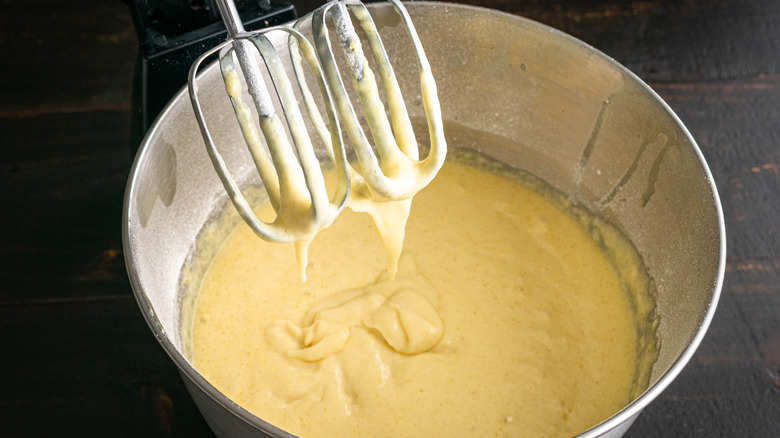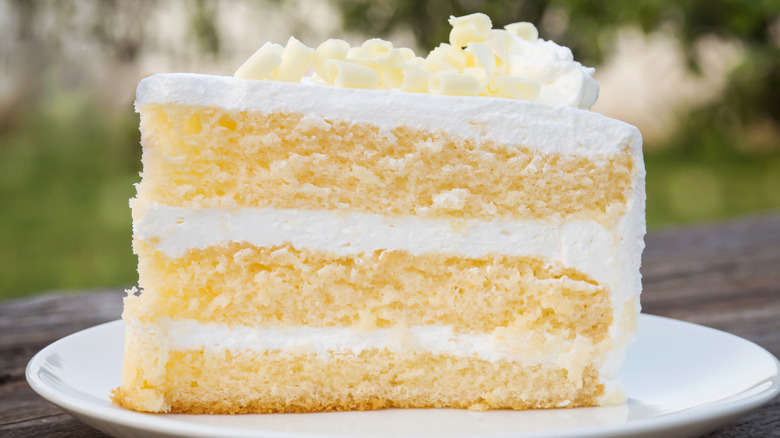Claire Saffitz's Tips For Mixing The Perfect Cake Batter
Baking a cake like a pro is a lofty task — getting the icing perfect and smooth and the decorations just right can be enough to give any novice baker a migraine, but the main attraction is the cake itself. Is it light and airy enough? Is it moist enough? Has it cooked evenly and risen as you wanted?
Mixing the perfect cake batter starts when you cream your butter and sugar together in your stand mixer — you'd better be using a stand mixer for this because it's nigh impossible to cream butter by hand. Professional patisseries have enormous mixers and chefs with decades of experience but worry not. Claire Saffitz, baking goddess and author of "Dessert Person" and "What's for Dessert" has some tips sure to make your cake-mixing — a piece of cake.
The food writer rose to internet celebritydom during her tenure at Bon Appétit. Her series "Gourmet Makes" found the chef continually finding inventive and exciting ways of recreating brand-name snacks at home, from Cheez-Its to Skittles. But baking has always been her passion, and after leaving her position with the site, Saffitz transitioned to cookbook writing and a YouTube channel of her own. She has over 1 million subscribers and uploads videos recreating recipes from her cookbooks, allowing her to go more in detail about cooking techniques that'll help you bake perfect cakes, pies, and much more.
Always scrape the bowl when you cream ingredients
Scraping the bowl down during the creaming stage is an important step to not forget when you're making cookies or cakes alike. The process aerates the batter — critical for cakes, especially, as creaming butter and sugar together creates air bubbles in the batter that allows the cake to rise nicely in the oven (via Baking Business). The actual science of how that happens, though, is fascinating.
In a video recipe for birthday cake, Claire Saffitz said, "This is a step that is going to lighten the batter. What happens is, the sugar crystals — they're sharp. They have this crystalline structure, they have sharp edges. When they get beaten against the side of the mixer by the paddle, the sugar crystals cut into the butter and create these little air pockets, and that air is providing leavening to the cake." She went on to say that scraping down the sides of the bowl is critical to every step of the cake-baking process, too. "A lot of successful cake-making for a butter cake is about scraping down the bowl really well," she notes.
Creaming with a stand mixer, you're going to wind up with the walls and bottom of the bowl coated in unincorporated butter and sugar, preventing the batter from completely homogenizing and endangering your precious uniform rise. So scrape the bowl and paddle regularly to make sure your batter stays consistent.
The reverse creaming method
An alternative way to mix cakes is called the "reverse-creaming method" aka the "paste" method. This method was popularized by "The Cake Bible" author Rose Levy Beranbaum and involves mixing the softened butter not into the sugar first, but into the dry ingredients (via King Arthur Baking Company). This way, the mixture resembles wet sand, turning into a proper batter once you add the liquids. Claire Saffitz used the method in a confetti cake recipe. "It is just a different method of mixing the batter that produces a very tender cake and really flat layers, so this is great if you're making a large volume of batter," she said.
So which method should you use next time you mix a cake — the traditional creaming method or the reverse? Food writer Summer Stone for The Cake Blog investigated the methods, finding that the reverse method minimizes gluten formation by coating the flour particles with fat from the butter, resulting in a moist, tender cake. This should also give you a "finer crumb" — the main draw of this particular style, she writes. You can use either method, depending on the recipe you're using and what you want the end result to be. With a little practice, you'll be baking cakes like the pros in no time.


